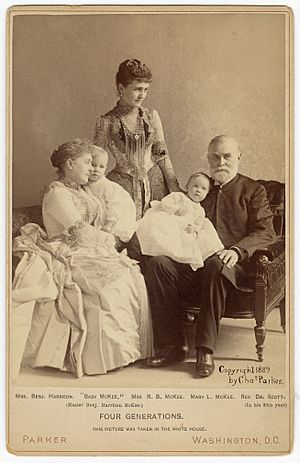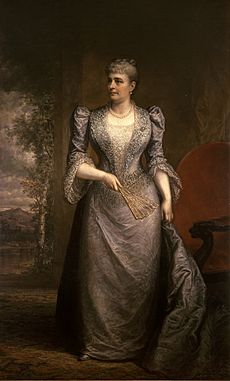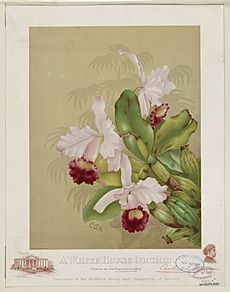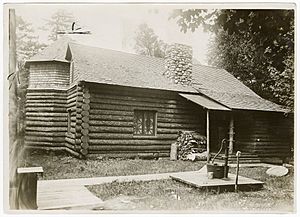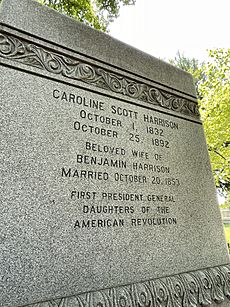Caroline Harrison facts for kids
Quick facts for kids
Caroline Harrison
|
|
|---|---|
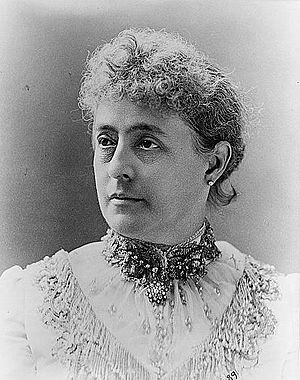
Portrait by Charles Parker, c. 1889
|
|
| First Lady of the United States | |
| In role March 4, 1889 – October 25, 1892 |
|
| President | Benjamin Harrison |
| Preceded by | Frances Cleveland |
| Succeeded by | Mary Harrison McKee (acting) |
| President General, National Society Daughters of the American Revolution | |
| In office 1890–1892 |
|
| Preceded by | Office established |
| Succeeded by | Mary Virginia Ellet Cabell (Vice President presiding) |
| Personal details | |
| Born |
Caroline Lavinia Scott
October 10, 1832 Oxford, Ohio, U.S. |
| Died | October 25, 1892 (aged 60) Washington, D.C., U.S. |
| Resting place | Crown Hill Cemetery |
| Spouse | |
| Children | 3, including Russell and Mary |
| Parent |
|
| Education | Miami University (BM) |
| Signature | |
Caroline Lavinia Harrison (born Scott; October 10, 1832 – October 25, 1892) was an American music teacher. She became the First Lady of the United States from 1889 until her death. She was married to President Benjamin Harrison. Caroline Harrison was the second first lady to pass away while serving in this important role.
Caroline was the daughter of a college professor. She received a good education and loved art, music, and books throughout her life. She married Benjamin Harrison in 1853. While he built his career in law and politics, she taught music. Caroline was very active in her community. She worked with her church, helped with charity, and managed local groups like an orphanage and a women's club. During the American Civil War, she supported the war effort by joining women's volunteer groups. When her husband was running for president, she helped host many visitors at their home.
As first lady, Caroline Harrison focused on charity work more than social events. She supported women's rights. She also helped start the Daughters of the American Revolution and was its first leader. Harrison led a big project to fix up the White House. She had many parts of the building and its systems completely redone. This included adding electricity, though her family was scared to use it! Her ideas for the White House later influenced how the East Wing and West Wing were built. She also started keeping records of all the furniture and items in the White House. This began the practice of preserving its history.
Contents
Caroline Harrison's Early Life
Caroline Lavinia Scott was born in Oxford, Ohio, on October 10, 1832. Her mother, Mary Potts Neal, was a teacher. Her father, John Witherspoon Scott, was a Presbyterian minister and professor. Caroline's parents were abolitionists, meaning they were against slavery. They even helped people escape slavery through the Underground Railroad. Her family was very educated. Her great-grandfather founded the first Presbyterian church in the U.S. and a college that later became Princeton University. Caroline had two sisters and two brothers. Her family called her "Carrie."
Her father left Miami University because of his strong anti-slavery beliefs. The family then moved to Cincinnati. Caroline's parents believed strongly in women's education. They made sure she received a good schooling. In Cincinnati, Caroline attended a girls' school that her father started. Her father also taught science and math at Farmer's College.
Caroline met Benjamin Harrison, one of her father's students at Farmer's College. They began dating secretly. They would often go on buggy and sleigh rides together. They also secretly attended dancing parties. These were not allowed at her father's strict institute. When Caroline's father became the first president of the Oxford Female Institute, the family moved back to Oxford. Benjamin transferred to Miami University to be near Caroline.
Caroline worked part-time at the institute, teaching art and music. She was also a student there. She and Benjamin got engaged in 1852. They planned to marry the next year. While Benjamin started his law career, Caroline taught music in Carrollton, Kentucky. She worked very hard there, and it affected her health. Because of this, she and Benjamin married sooner than planned. They were married on October 20, 1853. Caroline's father led the ceremony.
People often saw Benjamin and Caroline as very different. Benjamin was serious, while Caroline was friendly. After they married, they stayed at the Harrison family home in North Bend, Ohio. This was until Benjamin became a lawyer in 1854. Then, they moved to Indianapolis. The Harrisons did not have much money in their early marriage. Their family had been wealthy, but the money had spread out over many generations. Caroline managed their home while Benjamin worked as a lawyer.
In 1854, while pregnant with her first child, Caroline stayed at her family home in Ohio. Their lives became even harder when a fire destroyed their Indianapolis home that same year. The Harrisons had three children. Two of them lived to be adults. Russell Benjamin Harrison was born on August 12, 1854. Mary Scott Harrison was born on April 3, 1858. Another daughter passed away at birth in 1861.
The family became more comfortable as Benjamin's law career grew. Besides managing the house, Caroline enjoyed several hobbies. She started china painting and playing the piano and organ. Harrison also set up an art studio where she taught ceramics and other art forms. The Harrisons were active members of the First Presbyterian Church. Caroline sang in the church choir, joined the sewing society, and helped with fundraisers. She also taught Sunday school.
She was very involved in the community. In 1860, she joined the board of managers for the Indianapolis Orphans' Asylum. She stayed in this role until her death. She also served as president of the Indianapolis Woman's Club. Other groups she helped included the Indianapolis Benevolent Society, which gave aid to the community. She also helped the Home for Friendless Women, a retirement home for women.
Supporting the Civil War Effort
Caroline Harrison sometimes felt lonely and sad as her husband's political career began. He was often away, and their marriage suffered. This feeling grew stronger when the Civil War started. Both Caroline and Benjamin wanted to help with the war effort. Caroline joined volunteer groups like the Ladies Patriotic Association. She also joined the Ladies Sanitary Committee.
When she visited her husband at the soldiers' camp, she would mend uniforms and do other chores. When she was home in Indianapolis, she cared for wounded soldiers. After the war, she continued her education. She took literature and art classes. Her love for literature led her to start the Impromptu Club, a local book discussion group. Her art skills grew so much that she began showing her work in art exhibitions. She also joined the board of lady managers for Garfield Hospital.
In the 1880s, Harrison faced several serious health problems. She had a bad fall on the ice. She had surgery in 1883. She also became very ill in 1886. In 1874, the Harrisons oversaw the building of a sixteen-room house. It was finished in 1875. This experience in planning a home was very useful when she became first lady years later.
Benjamin continued his political career after the war. He ran for Governor of Indiana in 1876 but did not win. He was elected to the United States Senate in 1880. After his election, Caroline managed the family's move to a rented home in Washington, D.C.. She advised him in his political career and helped with his campaigns.
Her role as a family hostess grew a lot when her husband was chosen as the Republican candidate for president in 1888. He ran a "front porch campaign," which was common then. This meant thousands of people came through their home. Caroline also became a public figure herself. She was used in the campaign to show a contrast with the popular first lady at the time, Frances Cleveland. The campaign was stressful for Harrison. She hoped to find more privacy in the White House. Her husband was elected president and took office on March 4, 1889.
First Lady of the United States
As first lady, Caroline Harrison was in charge of a large family in the White House. Besides the president and herself, their two children and their families lived there. Caroline's father, her sister Elizabeth, and Elizabeth's widowed daughter also lived with them. Managing this big family made her seem like a caring grandmother. It also made her an example of ideal home life. Both her daughter and her daughter-in-law helped with the first lady's duties. She saw her home duties as her most important job. She was not very interested in her role as the White House hostess.
Harrison continued her artistic hobbies while she was first lady. She would send special ceramic milk sets to parents who named their children after the president. To connect with the public, Harrison arranged photos of her infant grandson, who was known as "Baby McKee." She also continued her charity work as first lady. This left her little time to plan big parties. She did make some changes for presidential receptions. Harrison stopped the practice of shaking hands in receiving lines. She also brought back dancing as a common activity. In 1889, Harrison caused a small political issue. She accepted a seaside cottage as a gift, which led to some accusations of bribery.
Harrison supported women's rights movements while serving as first lady. She advised her husband to appoint Alice Sanger to the White House staff. Alice was the first woman to hold such a position. Harrison also organized educational programs in the White House for the wives and daughters of cabinet members. These included ceramics and French classes.
In 1890, Harrison was one of the people who helped start the Daughters of the American Revolution. This was a women's group that celebrated the contributions of women during the founding of the United States. Her involvement gave the group importance. Her first speech to the group was the first public speech written and given by a first lady. That same year, she and other women helped raise money for the Johns Hopkins University Medical School. They did this on the condition that the school would accept women students. This was the first medical school in the U.S. to accept women. It led to similar policies in other medical schools.
White House Renovations and Preservation
When she became first lady, Harrison inspected the White House. She found many problems she wanted to fix. The building had damage from rot and pests like termites and rats. She talked with Thomas Edison about bringing electricity into the building. But he said it could not safely have electrical wiring in its current state. The large family also found there were not enough bedrooms. There was only one bathroom. She especially disliked that the family's living areas were open to public offices. This allowed visitors to access their private quarters.
She wanted to completely rebuild the White House. She even drew plans with architect Frederick D. Owen. However, Congress was not willing to pay for such a big project. Instead, Congress approved $35,000 for renovations, decoration, and updates.
Harrison made big changes with the money she received. The rooms were repainted. The drapes, carpets, and furniture coverings were replaced. The kitchens, which had not been updated in over forty years, were modernized. More bathrooms were added. New furniture was bought for the house. Wooden parts in the state rooms were repainted ivory. Five layers of floorboards were replaced because of rot.
She oversaw the installation of electrical wiring over four months. But the family and most of the staff were afraid to use the light switches! She also approved other updates. These included a new heating system and modern plumbing. The old wooden bathtubs were replaced with iron ones. To deal with the rat problem, she released ferrets. She also had the basement redone with concrete floors and tiled walls. For decoration, Harrison started using orchids as the official flowers for state receptions. She also had the first White House Christmas tree put up. The Green Room was redecorated in a fancy rococo style. By the time she finished, she had completely refurbished the White House. She was the first first lady to do so.
Harrison was interested in the history of the White House. She would offer personal tours. She stopped the practice of selling off furniture at the end of a president's term. This helped preserve historic pieces from past presidents. It also meant the White House did not always need new furniture. She was especially interested in china from previous presidents that was stored in the attic. She organized it and created what would become the White House china collection. She also designed her own china to be the official White House china for her husband's presidency.
She had her husband order a full list of all the furniture in the White House. This list documented the history of every item. One such item, the Resolute desk, was also used by later presidents. Under her management, the White House hired its first art curator. This practice was brought back by the Kennedy administration.
Illness and Passing
In 1891, it was discovered that Caroline Harrison had tuberculosis. As her health got worse, she gave her duties to relatives, mainly her daughter Mary. This caused some disagreements with other important women in Washington. She traveled to the Adirondack Mountains in the summer of 1892. The air there was thought to be good for tuberculosis patients. After her condition became very serious, she returned to the White House.
Her health worsened, and she faced personal challenges. Out of respect for her illness, both her husband and his opponent in the 1892 United States presidential election limited their campaign activities.
Caroline Harrison passed away on October 25, 1892. This was two weeks before her husband lost his bid for reelection. It is believed she died from tuberculosis combined with another illness, like typhoid fever or influenza. Early services were held in the East Room of the White House. Then, her body was taken back to Indianapolis for the final funeral at her church. She was buried at Crown Hill Cemetery. Her daughter Mary took over her duties as first lady for the rest of the term. In 1896, Benjamin Harrison married Mary Scott Dimmick, Caroline's niece.
Caroline Harrison's Legacy
Caroline Harrison is sometimes called an "underrated" first lady. She was more active than many other first ladies of her time. Historians often rank her in the lower group of first ladies. There has not been a lot of historical study about her. Early studies often focused on her role as a housekeeper. But her legacy is now seen as including her support for the arts, women's causes, and White House preservation. In 2018, a bronze statue of Harrison was placed in the Oxford Community Arts Center garden. This was the site of the Oxford Female Institute where she once studied and taught.
During her time, Harrison was praised for how well she managed the White House. However, as a White House hostess, she was not seen as very successful. She struggled to maintain good relationships with Washington society. She also lacked the grand style of past first ladies. Her wish for privacy often came before her public duties. She was often compared to and sometimes overshadowed by her predecessor, Frances Cleveland. Frances was much younger and very popular.
Today, historians recognize Harrison for her important renovation work in the White House. Her projects had a big impact on future presidencies. Her idea to remodel the White House, which was not approved at the time, later influenced a future renovation plan. This led to the building of the East Wing and West Wing. Frances Cleveland, who managed the White House both before and after Harrison, approved of the renovations. Harrison's work remains one of the most complete projects to affect the White House. Her efforts to preserve White House china and other furnishings started long-standing collections.
See also
 In Spanish: Caroline Harrison para niños
In Spanish: Caroline Harrison para niños
- Letitia Christian Tyler – wife of John Tyler who also died while serving as first lady
- Ellen Axson Wilson – wife of Woodrow Wilson who also died while serving as first lady


